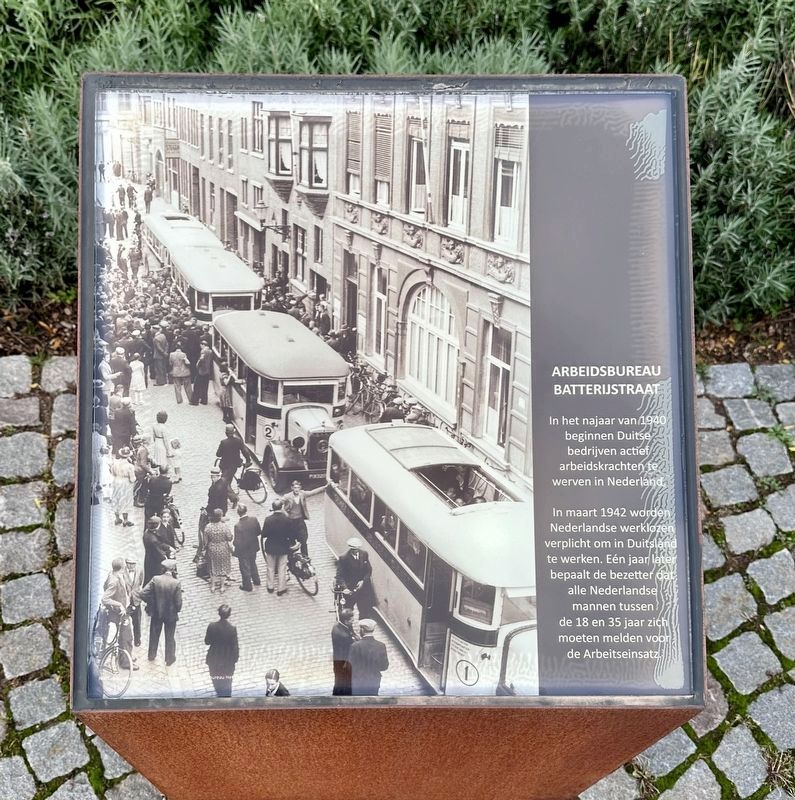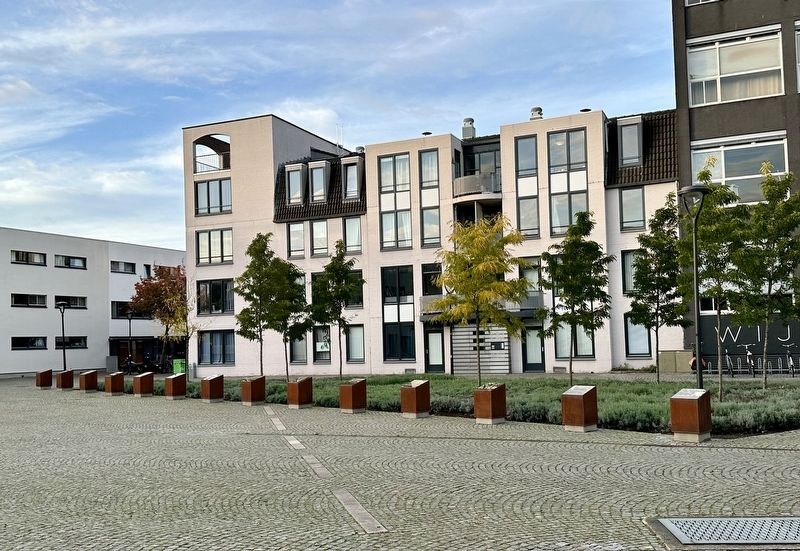Kommelkwartier in Maastricht, Limburg, Netherlands — Northwestern Europe
Herdenkingsplein (09): Arbeidsbureau Batterijstraat / Batterijstraat Employment Office
Inscription.
In maart 1942 worden Nederlandse werklozen verplicht om in Duitsland te werken. Eén jaar later bepaalt de bezetter dat alle Nederlandse mannen tussen de 18 en 35 jaar zich moeten melden voor de Arbeitseinsatz.
In the autumn of 1940, German companies started actively recruiting workers in the Netherlands.
In March 1942, Dutch unemployed were forced to work in Germany. One year later, the occupier determined that all Dutch men between the ages of 18 and 35 must register for the Arbeitseinsatz (“labor draft”).
Erected 2022.
Topics. This memorial is listed in these topic lists: Labor Unions • War, World II. A significant historical date for this entry is May 8, 1943.
Location. 50° 50.933′ N, 5° 40.936′ E. Marker is in Maastricht, Limburg. It is in Kommelkwartier. Memorial is on Herdenkingsplein, on the right when traveling west. Touch for map. Marker is in this post office area: Maastricht, Limburg 6211 PW, Netherlands. Touch for directions.
Other nearby markers. At least 8 other markers are within walking distance of this marker. Herdenkingsplein (10): Bombardement op Blauwdorp / Bombing of Blauwdorp (here, next to this marker); Herdenkingsplein (11): Amerikaanse Bevrijders / American Liberators (here, next to this marker); Herdenkingsplein (08): ‘Op de Bon’ / Food Coupons (here, next to this marker); Herdenkingsplein (12): Maastricht Commandocentrum / Maastricht Command Center (here, next to this marker); Herdenkingsplein (07): Schuilgelegenheid / Shelter (here, next to this marker); Herdenkingsplein (06): Persoonsregistratie / Personal Registration (a few steps from this marker); Herdenkingsplein (13): Politieke Delinquenten / Political Delinquents (a few steps from this marker); Herdenkingsplein (05): Hakenkruizen in de Grote Staat / Swastikas over the Grote Staat (a few steps from this marker). Touch for a list and map of all markers in Maastricht.
Also see . . . Mandatory registration for forced labour (Anne Frank House).
Excerpt: On 8 May 1943, the Nazis in the Netherlands announced the introduction of labour deployment (Arbeitseinsatz) for all Dutch men aged 18 to 35. This meant that they would be forced to work in Germany. The Dutch were required to show up and report for deployment. There were too few Germans left to do the work, because most of them had been drafted.(Submitted on February 16, 2024.)
The Nazis had expected to recruit 170,000 workers in the Netherlands, but only 54,000 menregistered. Most Dutch men did not want to work for the enemy. Many of them went into hiding, others arranged documents proving that they were incapacitated for work, or could not be missed at home or at work.
The Germans turned up the heat by increasing the target group to include all men aged 17 to 40 and by holding raids. Any man walking in the street was liable to be arrested and taken to Germany. The Germans eventually succeeded in deploying a quarter of a million Dutch men.
Credits. This page was last revised on February 16, 2024. It was originally submitted on February 16, 2024, by Andrew Ruppenstein of Lamorinda, California. This page has been viewed 41 times since then. Photos: 1, 2. submitted on February 16, 2024, by Andrew Ruppenstein of Lamorinda, California.

